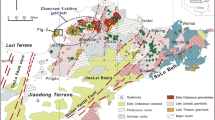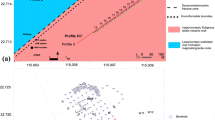Abstract
Preliminary geothermal surveys to identify areas of potential geothermal anomalies are the most important stage in traditional hydrothermal-type geothermal resource exploration procedures. Temperature gradient wells are limited because of their accessibility issues and high costs, whereas the 2 m survey is considered a rapid, efficient, and inexpensive method to measure temperature accurately and allow for rapid vectoring toward geothermal anomalies in cases where thermal groundwater is not overlain by near-surface cold aquifers. An improved quick and portable measurement device is developed that adds in situ thermal conductivity tests based on temperature. The device, which is easy to assemble, portable, and suitable for two or three people in field work, had been calibrated by laboratory experiments. The device was applied in Dongshan geothermal field, Xiamen City in China, and 18 measurement positions were arranged. Results clearly described the geothermal anomalies in the area and revealed two temperature anomaly centers, namely a strong one in the eastern area and a weak one in the western area. Moreover, a speculated fault provided a hydraulic connection between the eastern and western areas. According to the 2 m survey, a steady-state heat conduction model has been used to inverse the 20 m temperature. The average temperature error of all boreholes in 20 m is 3 °C, whereas the relative errors between actual and forecast values are less than 10 %. Therefore, the 2 m survey method and improved device shows good performance in preliminary geothermal surveys.














Similar content being viewed by others
References
Aretouyap Z, Nouck PN, Nouayou R (2016) A discussion of major geophysical methods used for geothermal exploration in Africa. Renew Sustain Energy Rev 58:775–781
Carslaw HS, Jaeger JC (1959) Conduction of heat in solids. Clarcdon Press, Oxford
Cartwright K (1974) Tracing shallow groundwater system by soil temperatures. Water Resour Res 10(4):847–855
Coolbaugh M, Sladek C, Faulds J, Zehner R, Oppliger G (2007) Use of rapid temperature measurements at a 2-meter depth to augment deeper temperature gradient drilling. In: Thirty-second workshop on geothermal reservoir engineering
Elachi C (1987) Introduction to the physics and techniques of remote sensing. Wiley, New York, p 413
Jia L, Guan X, Xu J (1986) An investigation into some problems of one meter thermometry in geothermal exploration. Geophys Geochem Explor 10(2):115–122
Kana JD, Djongyang N, Raïdandi D et al (2015) A review of geophysical methods for geothermal exploration. Renew Sustain Energy Rev 44:87–95
Kappelmeyer O (1957) The use of near surface temperature measurements for discovering anomalies due to causes at depths. Geophys Prospect 5(3):239–258
Kratt C, Sladek C, Coolbaugh MF (2010) Boom and bust with the latest 2 m temperature surveys: Dead Horse Wells, Hawthorne Army Depot, Terraced Hills and other areas in Nevada. Geotherm Resour Counc Trans 34:567–574
LeSchack LA, Lewis JE (1983) Geothermal prospecting with Shallo-Temp surveys. Geophysics 48:975–996
Manthena KC, Singh DN (2001) Measuring soil thermal resistivity in a geotechnical centrifuge. Int J Phys Model Geotech 1(4):29–34
Olmsted FH (1977) Use of temperature surveys at a depth of 1 meter in geothermal exploration in Nevada. United States Geological Survey Professional Paper, 1044-B, 25
Popov Y, Bayuk I, Parshin A (2012) New methods and instruments for determination of reservoir thermal properties. In: Proceedings, thirty-seventh workshop on geothermal reservoir engineering, Stanford University, Stanford, California
Rao MV, Singh DN (1998) Laboratory measurement of soil thermal resistivity. Geotech Eng Bull 7(3):179–199
Sladek C, Coolbaugh MF, Zehner RE (2007) Development of 2-meter soil temperature probes and results of temperature survey conducted at Desert Peak, Nevada, USA. Geotherm Resour Counc Trans 31:363–368
Sugawa A (1961) The distribution of the 1 m-depth ground-temperature by the various heat source. Geophys Bull Hokkaido Univ 9:21–32
Thompson GEK (1964) Proceedings of United Nations Conference on New Sources of Energy, vol 2, pp 386–401
Trexler DT, Koenig BA, Ghusn G Jr, Flynn T, Bell EJ (1982a) Low-to-moderate-temperature geothermal resource assessment for Nevada: area specific studies, Pumpernickel Valley, Carlin and Moana. United States Department of Energy Geothermal Energy Report DOE/NV/10220-1 (DE82018598)
Trexler DT, Koenig BA, Flynn T, Bruce JL, Ghusn G Jr (1982b) Low-to-moderate temperature geothermal resource assessment for Nevada: area specific studies, Final Report for the Period June 1, 1980–August 30, 1981: United States Department of Energy Geothermal Energy Report DOE/NV/10039-3 (DE81030487)
Urakami K (1968) On a method of the underground temperature prospecting. Geophys Bull Hokkaido Univ 20:1–13
Von Herzen V, Maxwell AE (1959) The measurement of thermal conductivity of deep-sea sediments by a needle-probe method. J Geophys Res 64(10):1557–1563
Wang J, Hu S, Pang Z et al (2012) Estimate of geothermal resources potential for hot dry rock in the continental area of China. Sci Technol Rev 30(32):25–31
Yuan XZ, Li N, Zhao XY et al (2010) Study of thermal conductivity model for unsaturated unfrozen and frozen soils. Rock Soil Mech 31(9):2089–2694
Zehner RE, Tullar KN, Rutledge E (2012) Effectiveness of 2-meter and geoprobe shallow temperature surveys in early stage geothermal exploration. Geotherm Resour Counc Trans 36:835–842
Zhang YJ, Yu ZW, Huang R et al (2009) Measurement of thermal conductivity and temperature effect of geotechnical material. Chin J Geotech Eng 31(2):213–217
Acknowledgments
This study was supported by the National High Technology Research and Development Program of China (863 Program) (No. 2012AA052803), the Natural Science Foundation of China (Grant No. 41372239). Some of the data set has been provided by Geological Engineering Investigation Institute of Xiamen City.
Author information
Authors and Affiliations
Corresponding author
Additional information
This article is part of a Topical Collection in Environmental Earth Sciences on “Subsurface Energy Storage II”, guest edited by Zhonghe Pang, Yanlong Kong, Haibing Shao, and Olaf Kolditz.
Rights and permissions
About this article
Cite this article
Zhang, Y., Xie, Y., Zhang, T. et al. 2 m survey method and its improved device application in Dongshan geothermal field in Xiamen in China. Environ Earth Sci 75, 1290 (2016). https://doi.org/10.1007/s12665-016-6048-9
Received:
Accepted:
Published:
DOI: https://doi.org/10.1007/s12665-016-6048-9




